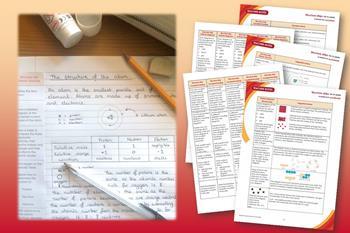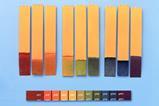Use margin-sized prompts to help learners independently write focused answers

When I was at school, the teacher would often ask us to make notes on a particular topic. They would give us a textbook and then leave us to it. Inevitably, we would end up copying out the textbook fairly indiscriminately, producing a few pages of notes and receiving a tick from the teacher. While that worked just fine for me, as a motivated student with decent prior knowledge, it most definitely didn’t meet the needs of everyone in the class.
Thankfully, our understanding of how students learn and how to support them on their journey to becoming successful independent learners has progressed. We now understand that they need guidance to chunk topics in the best way for learning and that it’s optimal that they actively engage with texts.
Structure strips provide a magic wand to overcome the fear of a blank page
Structure strips are a useful scaffold for students to complete independent work. They are strips of prompts and questions that fit into the margin of an A4 page. The students write their notes and answers next to each of the boxes. The boxes should be approximately the right size for the block of text they will add.
Structure strips (rsc.li/4drjeIP) are a useful scaffold for students to complete independent work. They are strips of prompts and questions that fit into the margin of an A4 page. The students write their notes and answers next to each of the boxes. The boxes should be approximately the right size for the block of text they will add.
Structure strips are a very versatile resource that can be used for different purposes at varying points in a learning cycle.
1. To support literacy
Put simply, structure strips get students to write. They seem to provide a magic wand to help them overcome the fear of a blank page. When I’ve used them with lower-achieving groups, learners have been amazed and proud of the work they produced using the strips.
I tend to use structure strips with textbooks, which gives an additional opportunity to develop general literacy skills, especially reading. For less confident groups, read the text together as a class and clarify the meaning of key vocabulary before learners attempt the structure strip activity. It’s worth checking that the textbooks you plan to use contain all the necessary information. Even better, give the students two different textbooks to really dial up their study skills.
2. At the start of a topic
Structure strips can help students get an overview of a topic or set of objectives before you progress to other focuses, such as application or evaluation. They can be a good knowledge leveller, for example at transition points where it is difficult to know exactly what they’ve covered in their prior learning.
3. At the end of a topic or for revision
By the time students have completed a sequence of learning, they should be able to tackle the prompts in structure strips without a supporting resource like a textbook. Using one pen colour, they can write their independent responses and then fill in any gaps using another colour. This helps them be specific with their revision later. Structure strips may include exam-style question prompts to challenge students.
4. For cover lessons
It can be tricky to plan for cover lessons as students all have different levels of prior knowledge and skills. Ideally, you need something that students can complete independently without having to trouble the cover teacher with questions, and there needs to be enough work to keep them busy and prevent mischief! Structure strips are designed to support students in completing independent work, so they fit the brief perfectly for a cover lesson, especially when used with textbooks. A structure strip would usually take 25 to 30 minutes to complete properly, so you’d need to include other activities as well. This could be reading time, defining key words or perhaps completing an exam question based on the structure strip, such as in this nanomaterials resource.
It can be tricky to plan for cover lessons as students all have different levels of prior knowledge and skills. Ideally, you need something that students can complete independently without having to trouble the cover teacher with questions, and there needs to be enough work to keep them busy and prevent mischief! Structure strips are designed to support students in completing independent work, so they fit the brief perfectly for a cover lesson, especially when used with textbooks. A structure strip would usually take 25 to 30 minutes to complete properly, so you’d need to include other activities as well. This could be reading time, defining key words or perhaps completing an exam question based on the structure strip, such as in this nanomaterials resource (rsc.li/3JrX3EM).
5. For homework
You can use structure strips for homework. However, you’ll need to plan carefully to make sure students have the same access to support resources so they can be successful. It can be tempting to just tell students to use the internet, but they will need your help to choose good sites with appropriate content.
More like this
- Teaching metallic bonding at 14–16? Use this scaffolded writing activity to get students to describe the metallic bonding model and explain how this leads to particular properties in metals.
- Or ionic bonding at 14–16? Here’s another structure strip activity to help your students understand the models and diagrams used to represent ions and their bonds.
- Help your learners understand covalent bonding diagrams and their limitations with this structure strip activity.
- When teaching allotropes of carbon, help your students retrieve information on the structure and bonding in different forms of carbon.
Kristy Turner















No comments yet